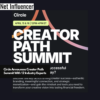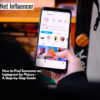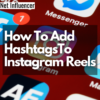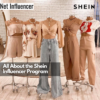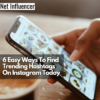Influencer
When Creators Lead: Raymond Cua’s Case For Creative Freedom
Most travel destinations want creators to hit tourist hotspots and iconic restaurants. However, not a few people in the industry are of the opinion that this approach seems to be losing its appeal and effectiveness.
A guest essay in The New York Times argues that “food tourism has become a victim of its own success. You no longer need to visit Paris for macarons from Ladurée when you can find them at shops in major U.S. cities or have them delivered to your home.”
With global foods more accessible than ever, culinary exploration is now focusing more and more on, according to the essay, “Third-culture cuisines at the intersections of tradition, immigration, and diaspora.”
One creator who has been using this approach to food content with remarkable success is blogger Raymond Cua.
As founder of Traveling Foodie, Raymond built a distinctive multi-platform brand across YouTube, Instagram, TikTok, Facebook, and his website. His approach transforms standard marketing briefs into unexpected storytelling opportunities, replacing polished tourism shots with late-night food crawls, hidden neighborhood gems, and community stories.
This unconventional strategy, developed over ten years, demonstrates how creative independence leads to content that resonates with audiences while achieving brand objectives.
He convinced Canadian tourism DMO ‘Visit Mississauga’ to let him spend 24 hours eating at a suburban food plaza instead of traditional tourist spots. The result? His distinctive content generated a year’s worth of watch time in just four months, transforming a local food plaza into a viral destination.
From Personal Documentation to Strategic Innovation
When Raymond started posting publicly in 2014, he had no marketing playbook to follow. “I’ve been creating content on my personal Facebook for a long time. It initially started as a way to document my travels and remember places I’ve seen and eaten,” he explains. “Along the way, with family and friends, I’ve become their go-to ‘guide.’ They ask me for recommendations. And I started Instagram to share with more people who might find them useful too.”
This natural progression from personal passion to trusted resource shaped his future approach to brand partnerships.
“I studied Computer Science and had no background in marketing or journalism when I started blogging,” Raymond admits. “For me, it was really passion-driven since I traveled and dined out a lot already.” Unbound by industry conventions, this perspective became his greatest asset in reimagining brand collaborations.
Creative Freedom Drives Results
Raymond’s work with Visit Mississauga shows how his distinctive approach delivers exceptional outcomes. Their initial partnership focused on unique restaurant discoveries: “I personally chose restaurants where I found, ‘Hey, I haven’t really seen this kind of thing in my travels’ or ‘It’s very rare to find.'”
The success of this first collaboration led to an even bolder second project sparked by audience engagement. “Someone commented, ‘Hey, you should also check out this plaza in Mississauga; it’s kind of popular right now among locals, but it’s not popular outside Mississauga.'”
Rather than proposing a standard tourism campaign, Raymond suggested something unexpected: “I want the story angle to be 24 hours – that is, 24 hours of only eating at that plaza. And they greenlighted that idea. I had full reins on what happens.”
His comprehensive coverage revealed surprising findings: “I ate my way from lunch one day all through to lunch the next day I ate at that plaza… It was nice to see how the plaza transitions in different parts of the day. I was shocked to see that at 1 a.m., that plaza was bustling. Like there were so many people at 1 a.m. on a Monday with some spots having a line.” The content showcased remarkable diversity: “I tried Mexican cuisine, Chinese, there’s also Peruvian and then a bunch of different Middle Eastern [food]. It was my first time trying Yemeni coffee.”
The campaign surpassed all performance metrics. “It went viral almost immediately. In only four months, that new video has enough watch time of more than one year,” Raymond shares, noting that the video is still growing.
The success amplified across his content: “As that new video was going viral, it was bringing views to the other Mississauga video… they kind of became synergistic between each other.” This also prompted Visit Mississauga to embrace Raymond’s creative approach for future collaborations, highlighting creator autonomy in strengthening brand partnerships.
Multi-Platform Strategy: Maximizing Partnership Impact
Raymond’s success extends beyond creative concepts to his strategic use of multiple platforms. “I’m able to offer both depth and breadth content-wise,” he explains. “If you’re just an influencer only on Instagram, that’s the only thing you can offer a potential partner. But with me, because different partners have different needs, I’m able to basically cater to any of those needs.”
This multi-platform approach allows him to create complementary content that amplifies each campaign’s impact. His strategies range from long-form YouTube videos that showcase detailed experiences to comprehensive travel guides on the website to quick TikTok, and Instagram highlights that drive viral engagement.
From Single Projects to Long-Term Partnerships
Raymond’s partnership success stems from methodical relationship building, particularly at industry events like IPW (International Powwow), the largest travel conference in the United States.
“The ones I have been consistently doing for the past two years, and I’m attending this year, are called IPW… It’s the largest travel conference in the U.S., and it happens annually in May or June, normally in changing host cities,” he explains.
His approach to these events follows a clear strategy. “What’s great is it has two parts. There’s a press part where there is one day where we’re doing a whole day of speed dating with potential partners,” Raymond shares. “Prior to the conference, we book appointments with 20 destinations or tourism companies that we want to have meetings with. Then, at the conference, one whole day from 9 a.m. to 3 p.m., the speed networking style is based on those appointments. The second part is an exhibitor floor with booths where people from tourism, travel companies, and agencies can drop by and meet.”
These connections often yield results over time. “Even though there were no concrete partnerships from some initial meetings, we’ve kept in touch,” he explains. “And then on the second IPW, when I met them again, they were like, ‘Hey, let’s actually talk; we might be able to partner.'”
IPW also offers some unique experiences. At last year’s conference in Los Angeles, attendees earned special access: “The closing event was in Universal Studios, where they shut down the entire amusement park for the conference for three whole hours. And it was like unlimited rides. All the characters were out for us. There was the red carpet treatment, unlimited food and drinks. This is something I will never experience as a normal visitor.”
Maintaining Trust Through Balance
As audiences grow more discerning about sponsored content and savvier about Instagram vs reality, Raymond maintains credibility through strategic content balance. “Nowadays, the automatic default of consumers is thinking everything’s an ad in general,” he observes. “They are now craving to see things that are more raw and less of an ad.”
His strategy involves maintaining substantial organic content alongside partnerships. “I’m not saying less sponsored, but you need more organic content for balance,” Raymond emphasizes. “If your account is purely sponsored content, it gets boring and stale. At the same time, it can potentially show that you’re not as passionate and may just be doing it for the money.”
To demonstrate a genuine interest in travel, Raymond regularly pursues personal projects. His recent month-long trip to Turkey exemplifies this approach: “I went to Istanbul, Cappadocia, and did a 2-week road trip along the Turkish coast from Antalya to Izmir. That was just me doing my own thing. When they see that, they know that this is the guy who actually enjoys traveling for the sake of traveling and sharing about it. I don’t travel nor produce content only if it’s sponsored travel.”
This balanced strategy enables diverse storytelling. “You’re able to tell different stories if it’s sponsored or not,” he explains. “Obviously, if it’s sponsored, you can sometimes only tell a story in a certain way… but also, at the same time, that story is sometimes based on the client’s desired direction. Whereas, for example, in my own projects, I can do whatever I want. There are projects that I want to do that I feel are fun and nice for the audience, but it may not align with what the sponsors or brands want and their goals.”
Shaping Future Partnerships
As social media platforms introduce new features monthly and audience preferences shift, Raymond sees opportunities and challenges ahead, noting changing algorithms, emerging tech (like AI), influx of influencers, and sophisticated audience expectations about content.
“It’s always changing. So, it doesn’t get boring; it doesn’t get stale. It kind of keeps you on your toes, sometimes in a good way, sometimes in a bad way,” Raymond reflects. This constant adaptation has led him to focus on diversification and flexibility in his partnership strategy.
His experience demonstrates that successful partnerships require mutual trust and understanding. “Partnerships are both ways,” he emphasizes. “The content that succeeds the best for me is the ones where the partner just gave me full creative reins.”




